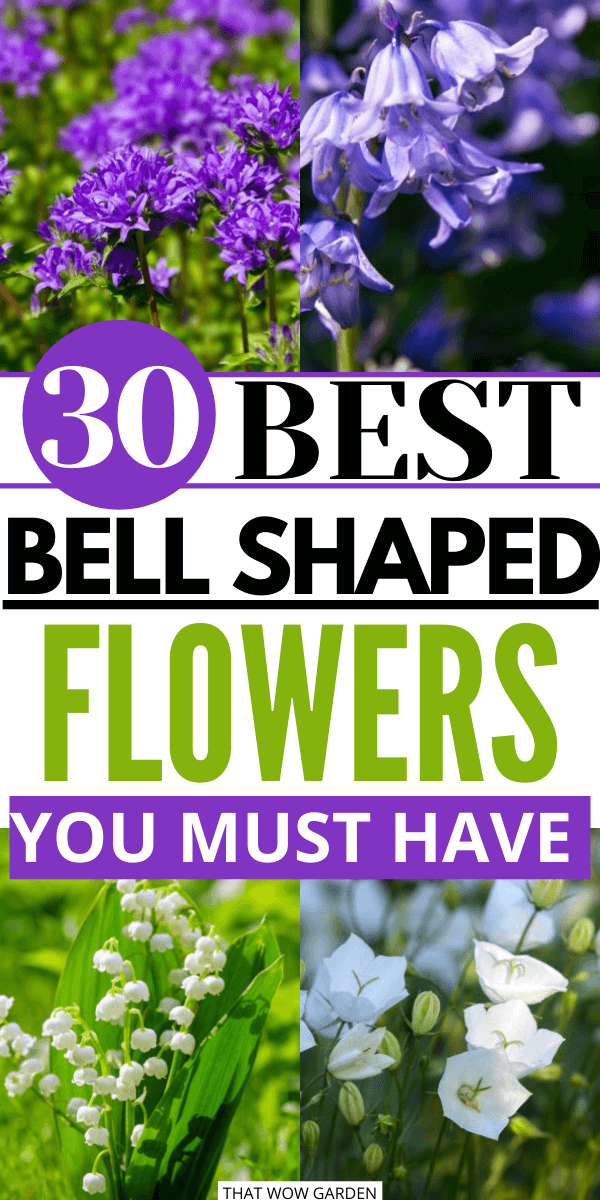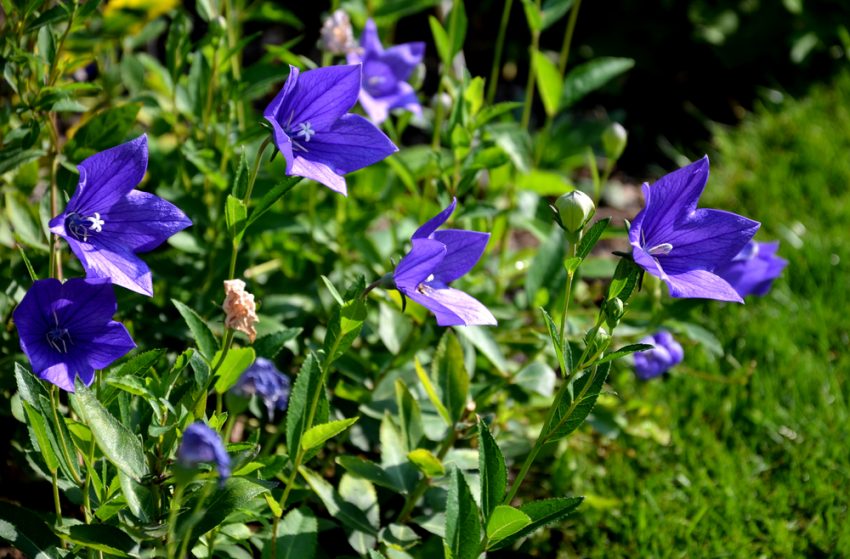There is just something so whimsical about bell-shaped flowers. I feel as if I’m in a Disney movie. I’m sure there is nothing you want more than to see some gorgeous bell-shaped flowers grow in your backyard. Well, you are at the right place! These blooms are unique and beautiful and will instantly uplift the mood of your garden.
With so many bellflower options out there it is understandable to get confused and overwhelmed.
We’ve made the job much easier for you. Below are the 30 best bell-shaped flowers that will make your backyard look like a scene from an Audrey Hepburn movie.
30 Best Bell Shaped Flowers
1. Common Bluebells
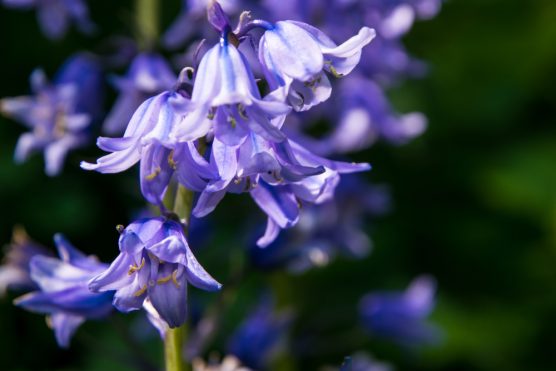
The name describes the flower perfectly. Bluebells are quite common in the UK. Especially in the summer months. You’ll see them all over the country. The fact that they have beautiful blooms separates it from the other wild plants. These blue and violet (occasionally pink) bellflowers are stunning and are quite easy to handle.
They are pretty low maintenance and when grown under the right conditions, may last annually. All they need is adequate sunlight and well-drained soil. It grows up to 11 inches in height and is the ideal pop of color your backyard needs.
2. Bellflower White Clips (Campanula carpatica)
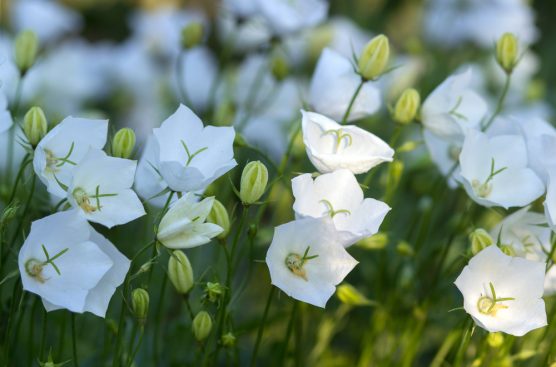
White Clips are the famous version of the bellflower blue clips. The flowers are ideal for small spaces or container growing. They don’t have many requirements. You need to make sure they are planted in the sun, or somewhere where you get partial sunlight.
White Clips are ideal for summer and have an extended bloom time (up to 4 weeks). They need regular watering once a day. To plant your white clips, dig a hole 3 inches deep in your soil and plant them. They attract butterflies and don’t need a lot of groundcovers.
3. Raven (Penstemon)
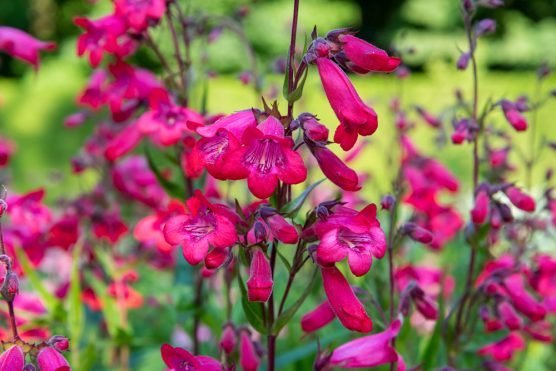
These flowers are a rich deep berry color that will give a perfect splash of color to your backyard. These flowers need to be planted in sunlight or partial sunlight. Raven is best suited for the summer months (June to October). These will bloom in summer and slowly diminish as the frost begins to settle in.
They don’t require a lot of maintenance, just make sure to remove the faded blooms regularly so that the bells have a prolonged bloom. When there are congested blooms, just lift and divide them. Ravens are great plants for pollination and attract bees. About mid-high these bells are stunning.
4. Lily of the Valley (Convallaria Majalis)
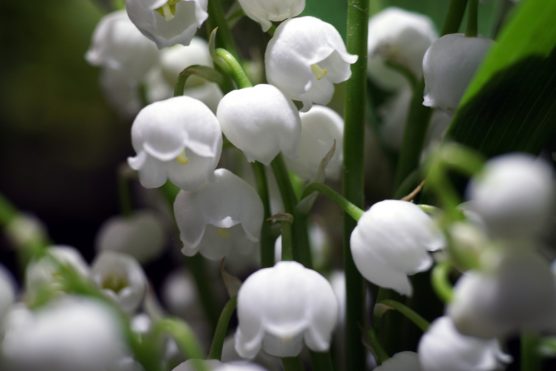
These are also known as May Bells and they grow perineally. You may find them growing naturally in forest areas. They require partial sunlight and moist soil to grow. You should ideally plant these flowers in late fall so that they can get the cool dormant period they require.
Lily of the Valley produces small red berries after it is in bloom. You have to be careful that you don’t ingest these berries as they are typically wild. In the right climate, they may also survive annually.
5. Foxglove (Digitalis purpurea)
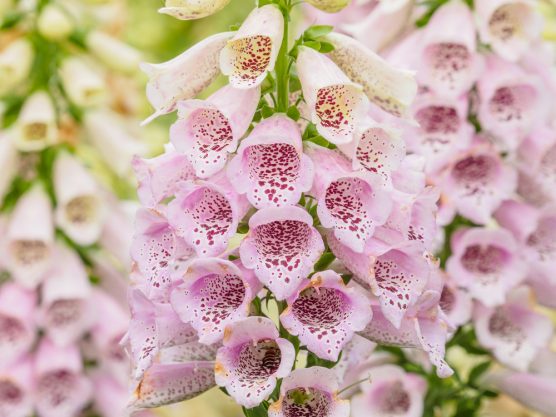
These plants are so eye-catching they instantly make you go wow. These are long plants with bell flowers colored pink, red, and white. They usually survive for only two seasons but can be perennial if provided with the right temperature. These bloom in the early summer months or in spring if you live in a warm climate.
They are commonly known to be very poisonous so you should avoid growing them if you have young children or pets. But it also prevents wildlife from entering your backyard and looks pretty. A sweet 2 in 1 deal if you ask me
6. Clustered Bellflower (Campanula glomerata)
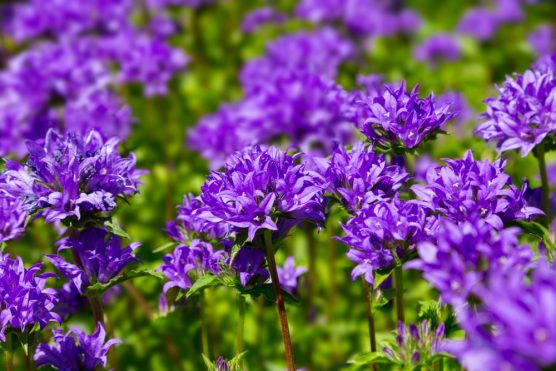
These are beautiful purple blooms that are very common as wedding flowers. They almost make a bouquet of their own. Purple is quite unique in color and will stand well against brick walls or acid greens.
This requires full sun to partial sun and usually blooms in summer. They do require quite a bit of water so make sure you water them regularly. If the clusters are too intrinsic and full, use the lift and divide method to space them out.
7. Native Yellow Bellflower (Uvularia grandiflora)
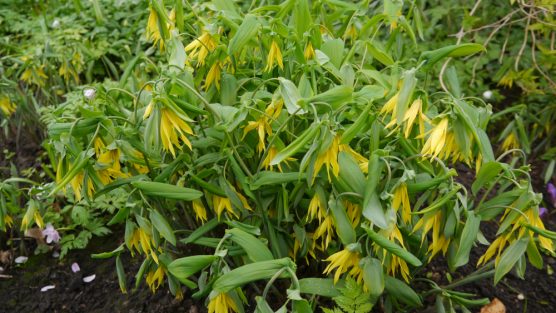
These are native to the United States and for good reason as well. They deal well with dry climates, drought and prefer well-drained soil. They are a treat to watch as they give your whole garden a sunkissed look. These bellflowers require full to partial sunlight and usually bloom around late spring or early spring.
You have to make sure to water these regularly. They look precious in a wildflower garden and don’t grow that tall (standing at about 18 – 20 inches). A native yellow bellflower works excellently for container growing as well.
8. Peach Leaved Bellflower (Campanula persicifolia)
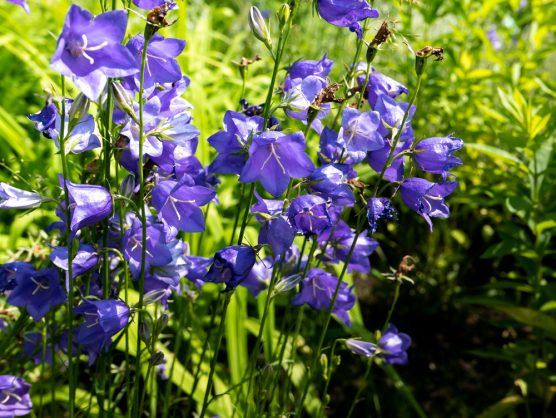
These bellflowers are tough perennials that are great if you live in a relatively warmer climate. They either have violet or white blooms and usually bloom the most during summer or midsummer. It requires full or partial sunlight and well-drained soil. It doesn’t grow that tall and stands at a modest 3 feet height.
To increase its period of blooming regularly remove the faded blooms regularly. They have a decent amount of groundcover and hence it will look stunning as a perimeter plant around your garden.
9. Snowdrops (Galanthus Nivalis)
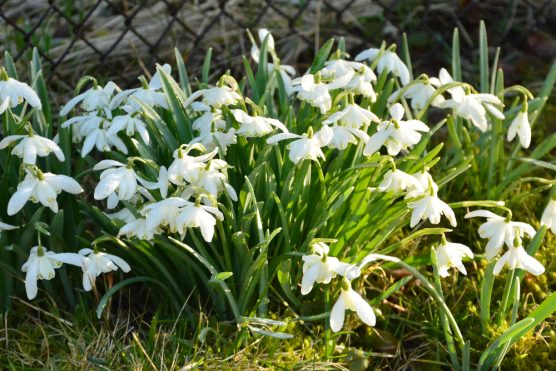
Snowdrops are beautiful white flowers that are frost hardy. They bloom during late winter or early spring. They are not that tall and stand at about 3 – 6 inches in height. These plants mature slowly and may take up to 3 – 4 years to reach their full height and bloom accordingly.
You can plant them in the fall so that you give them enough time to bloom and grow till winter. They don’t require copious amounts of sunlight. Snowdrops bloom beautifully even when there is snow on the ground. Hence it’s perfect for the cooler climates.
10. Virginia Bluebells
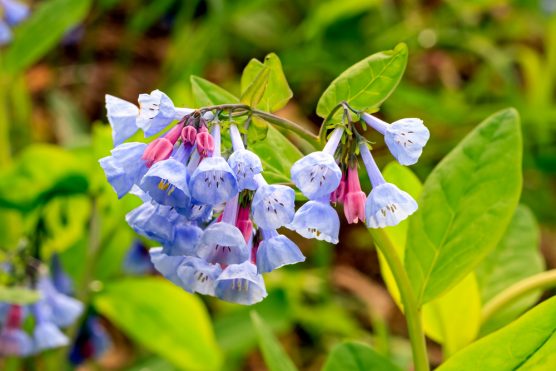
This is one of the prettiest bell flowers out there. It adds a great touch of spring to your garden. You hardly see them in the wildlife as they are endangered but you can grow them natively in your garden. Virginia Bluebell is a summer plant and starts to go in full bloom during mid-spring and lasts till mid-summer. After that it becomes dormant.
They grow as tall as 24 inches and great plants for pollinating. Virginia Bluebells also has a sweet smell that will refresh your garden. They need full to partial sunlight. If you choose the right spot, you won’t have to do much to take care of this plant. It is suitable for container growing but just avoid shifting the plants.
11. Classic Bellflowers (Campanula)
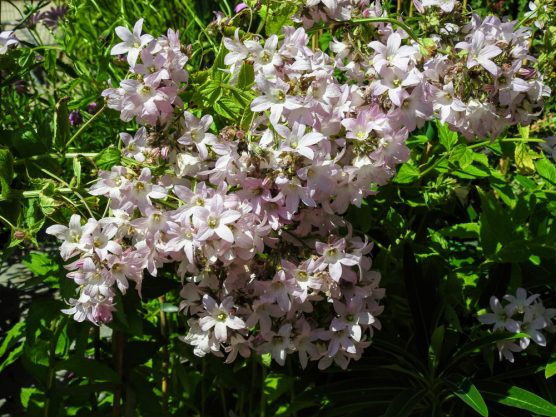
These are the classic bellflowers and you really can’t go wrong with these. They come in summery shades such as blue, lavender, white, and pink. They have good ground cover, its foliage is rich and green and looks quite gorgeous. Bellflowers are great plants for encouraging pollination and attracts a lot of bees and butterflies.
It needs full to partial sunlight and has a prolonged bloom time (starting from mid-spring till the end of summer). It is relatively low maintenance. All you need to do is find a spot that has good sunlight and some well-drained soil. Its height ranges between 1-3 ft and so it’s not that tall and lucrative to take care of.
12. Angel Wing Begonia (Bamboo Begonia)
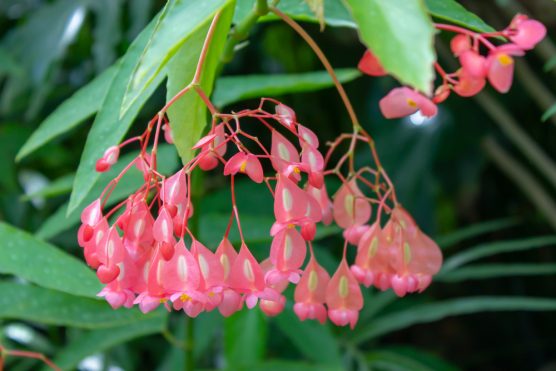
Angel Wing is a very common house plant that grows to be quite tall. These plants can grow up to 10 ft. If you encourage the right kind of greater in suitable conditions then you can have clusters of flowers all year round. This plant can also be grown in containers, albeit it demands a little more care and attention.
Angel Wing has the most gorgeous foliage (glossy green and red in color) which complement the flowers even more. You will definitely not regret adding some of these to your home or backyard.
13. Angel’s Trumpet (Brugmansia spp.)
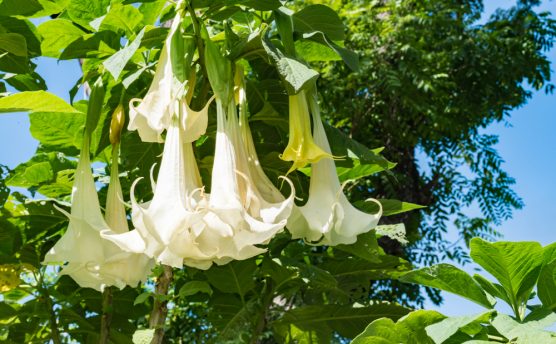
While these plants grow best in tropical regions, they can be brought indoors during the frosty months. They grow just as well indoors in containers. These shrubs or small trees are a tropical dream and have the most vivacious flowers ever. Tropical plants need an adequate amount of sunlight.
Although you have to be careful while working with these plants as they can be toxic to humans as well as pets. So just make sure that you wear gloves while working with these plants. Angel’s Trumpets are amazing pollination plants and attract a lot of bees and hummingbirds.
14. Fuschia
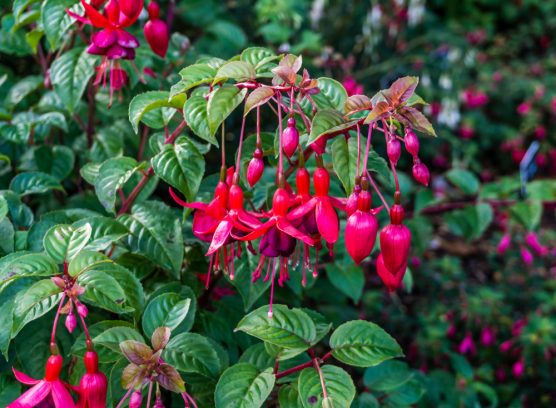
These might be the most unique colored plants. They are a beautiful mix of Magenta and Purple. These perennial plants are frost hardy and are ideal for cool temperatures. Sunlight is not that big of a priority for these plants. These plants look stunning in hanging baskets as well..
This plant is shift friendly and can easily be moved from outdoors to indoors. They thrive when the temperature drops low and the blooming period can be prolonged if you regularly deadhead and fertilize the plant.
15. Bells of Ireland (Moluccella Laevis)
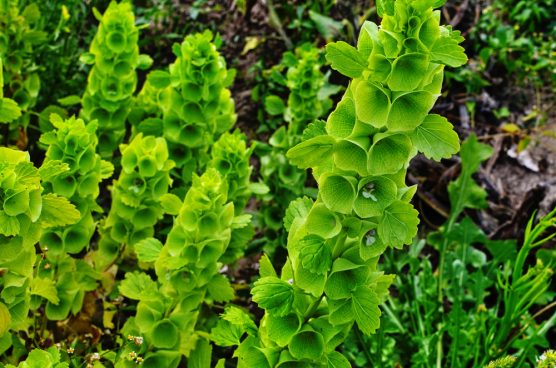
This is quite possibly the most unique flower you will ever come across. You might think that these green flowers make the plant look boring. You couldn’t be farther away from the truth. These tall plants have a lot of character and will definitely stand out in your garden.
They stand at about 3 – 4 feet tall and require full to partial sunlight with well-drained soil. Commonly used for St. Patricks day bouquets: these plants are quickly becoming the new trend. Did I mention that they smell like vanilla?
16. Spanish Bluebells (Hyacinthoides hispanica)
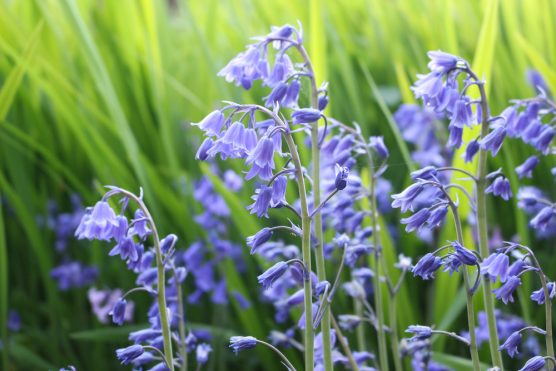
These gorgeous bells are perfect for a cool and frosty climate. If you live somewhere that experiences a lot of cold then these flowers will work beautifully. You can plant them sometime in the fall so that they are tall and in full bloom as winter and early spring comes. These plants attract a lot of butterflies and bees to your garden. They are also immune to wild animals like rabbits and deer so if you get a lot of wildlife in your backyard, you don’t have to worry about your bluebells.
You can leave these seeds in the ground to grow again in the winter next year, and if you live in a tropical climate you can leave them to grow annually.
17. Daffodil
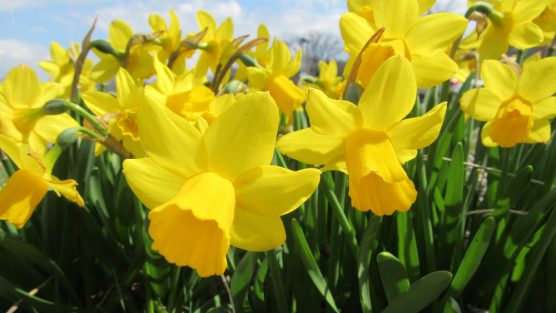
Daffodil is well known in the gardening world. And no I’m not just saying this because William Wordsworth wrote a poem on it. They have star-shaped petals with a trumpet looking middle. They grow in clusters and are a delight to watch. Usually, it is seen in a bright sunshine yellow, but can occasionally be spotted in white or orange as well. Although they don’t bloom until mid-spring, they should be planted in fall so that they can have a cool dormant period.
Daffodils require full to partial sunlight. They will make a stunning addition to your backyard, especially because they can make great cut flowers.
18. Coral Bells (Heuchera)
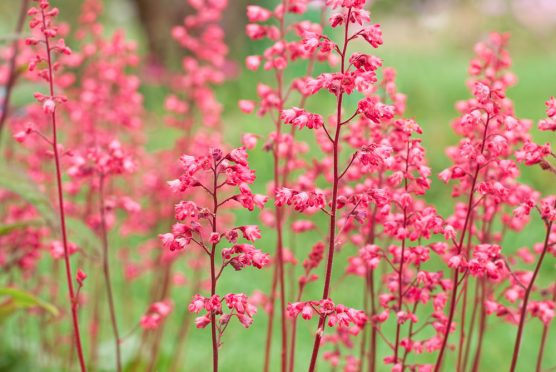
Coral Bells are more commonly known as foliage plants and come in a variety of colors such as red, green, gold, or even purple. They thrive when planted in numerous amounts. Many people use these as groundcovers and plant them in abundance.
They add a nice pop of color and grow the most adorable little bellflower; which can be used for decorating purposes. They don’t need a lot of sunlight and go perfectly well in no shade. They are relatively tall and act as a great perimeter plant for your garden.
19. Muscari (Grape Hyacinth)
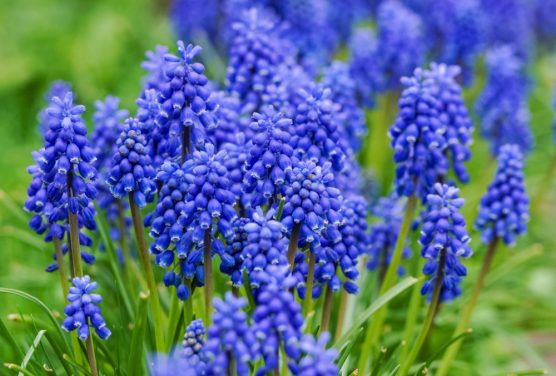
Muscaris are so gorgeous they can easily be my favorite bellflower. Also known as Grape Hyacinth the name could not be any more fitting as it looks like a bunch of grapes on a stalk. These plants are short that only grow up to 6 – 8 inches. They are summer plants that thrive in full or partial sunlight.
Muscari has its prime bloom time during mid-spring. Not only do they stand out when planted by themselves; they also act as excellent complimentary flowers. Many choose to plant it with some tulips as both bloom their finest during spring. If planted in the right conditions and treated properly, they will come back annually.
20. Penstemon (Beardtongue Flower)
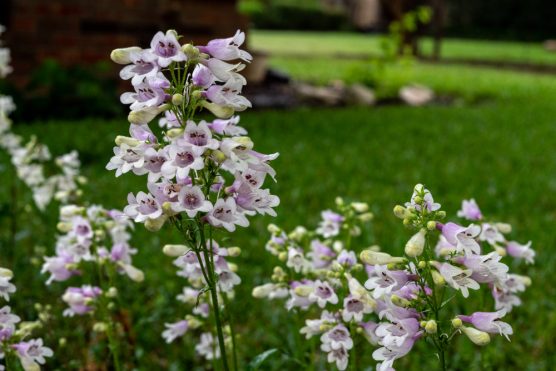
We covered the Raven Penstemon above and now it’s time for the Beardtongue flower. Penstemon has a variety of different types and colors. While the growing conditions are similar, if taken care of properly it can last perineally.
While being stunning, they also attract a lot of bees and butterflies which can assist your other plants with pollination. Usually, these flowers are red and white but sometimes they also come yellow in color.
21. Trumpet Vine (Campsis radicans)
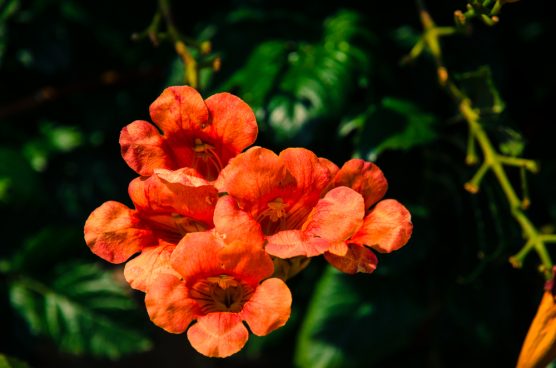
These are quite easily one of the most eye-catching bellflowers as they are orange in color. But with great beauty comes great responsibility. These plants can become quite the hassle to handle as they usually choke up other plants.
They are relatively difficult to contain and hence they aren’t that common. But if you are an experienced gardener, you won’t have to lose a moment of sleep over this. Trumpets require a lot of sunshine for them to bloom properly. If not given enough sunshine and fertilizer, it might take years to bloom properly.
22. White Mountain Heather (Cassiope mertensiana)
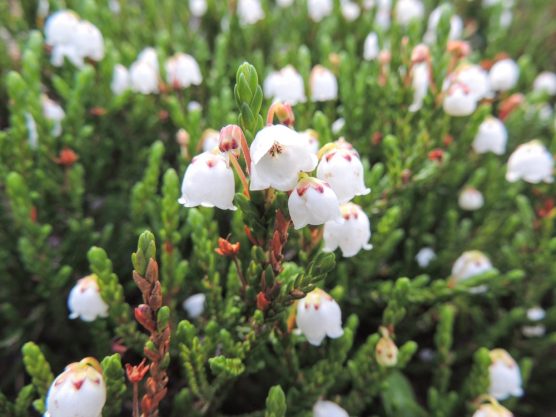
As explained in the title, these plants are usually found on hills or ridges. These plants have gorgeous white flowers and are evergreen. These plants are about average height, standing at 10 – 12 inches tall. It’s a shrub-like plant that blooms magnificently in the summer. Some sunlight paired with well-drained soil is all this plant needs to thrive.
If taken care of regularly, these plants can last perineally. The white of the flowers acts as a beautiful contrast against the green foliage. All in all this plant bores stunning bellflowers.
23. Canterbury Bells (Gloxinia perennis)
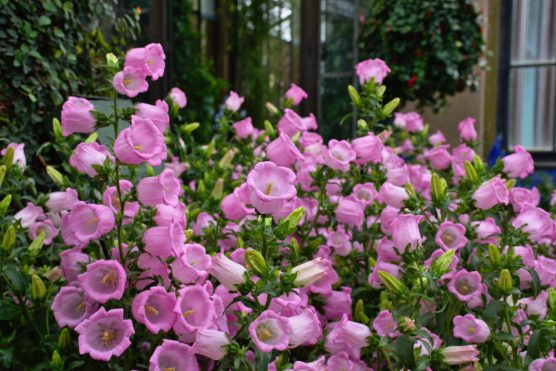
This is a biennial plant that stands tall at around 36 inches in height. These are summer plants through and through. Coming in a variety of colors like blue, pink, white, and purple these look right out of a fairytale. These plants thrive in summer. They need full sunlight.
The stalks might weaken if they grow in partial sunlight. They make a great garden plant as they are quite easy to handle and you don’t need much gardening experience.
24. Twinflower (Linnaea borealis)
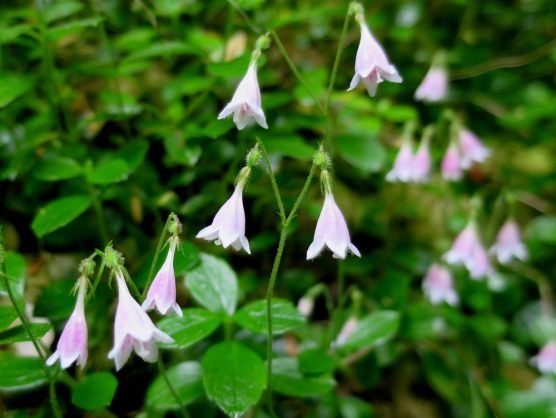
As the name suggests, if you look closely you’ll notice that this plant has flowers that bloom in pairs. It’s commonly seen growing in pine woods. The flower is either pink or white. These bell flowers are quite rare, probably because they are so pretty. It doesn’t need that much sunlight and grows well in moist soil.
Twin Flowers are highly fragrant and smell divine. They bloom around June and July depending on the climatic conditions. While the bloom doesn’t last long it is worth the wait.
25. Swamp Doghobble (Eubotrys racemosa)
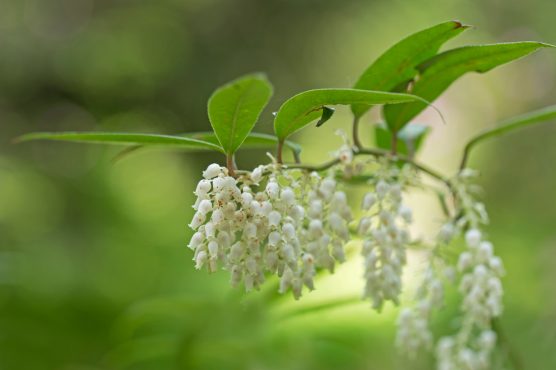
It’s a shrub that grows in partially shaded areas. It bores the most beautiful white bell-shaped flowers. As the name suggests, these grow in moist and damp areas like swamps. They have a relatively long flowering period and emanate a very sweet fragrance that is divine. It does not require that much sunlight, only moist soil. The plant grows up to 10 – 15 inches. Although you have to be careful as these are poisonous and might prove to be fatal once ingested by animals or humans.
26. Korean Bellflower
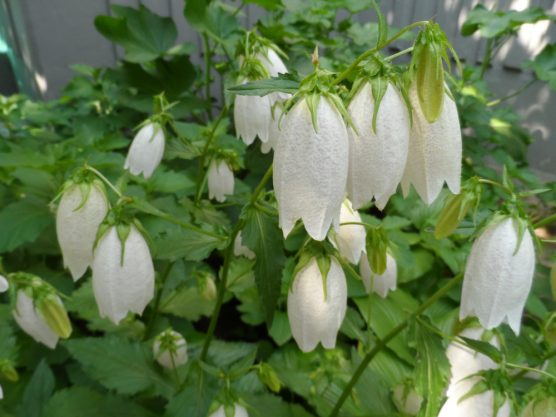
This bellflower comes in white as well as purple. It is stunning and long shaped and hangs upside down. The flowers usually grow in clusters and are well contrasted against the rich green foliage. This is a summer plant that thrives during the summer and blooms the best during that time.
It has a sweet fragrance and smells divine. If the clusters are too close, I’m sure you know about the lift and divide method by now. These flowers are also known as ‘Elizabeth’ flowers and have a relatively long blooming period (from early summer to mid-fall.)
27. Adriatic Bellflower
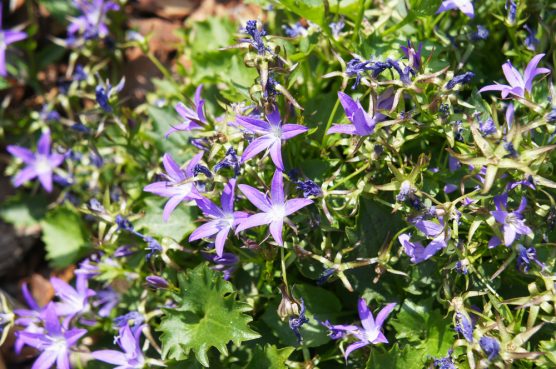
This stunning plant doesn’t take too long to expand so make sure you have enough space for it. It has a nice ground cover and has stunning teeth like petals. The color ranges from light blue to lavender. These bellflowers can also handle a bit of frost and can last perennially if grown in the right conditions.
The flower contrasts beautifully against the foliage. A lot of people use this as a border to decorate their walls to make it seem like a cottage. It is quite easy to take care of and doesn’t grow that high.
28. Dalmatian Bellflower (Campanula portenschlagiana)
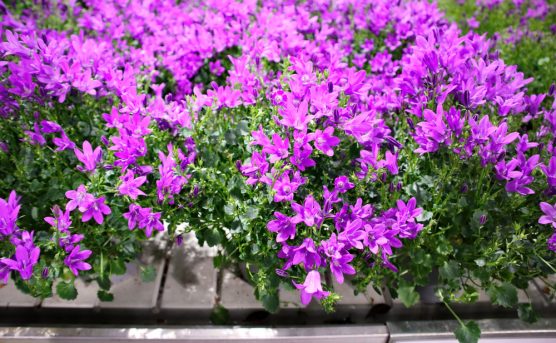
While you might be thinking that this is named after a dog breed, it is actually named after the Southeastern European country of Croatia. This bushy plant will stay green as the frost hits, but will only bloom during the summer period.
This plant needs full to partial sunlight in order to bloom into glory. To further prolong the blooming period, make sure you trim the plant regularly when the leaves begin to turn brown. This plant needs to be planted in moist soil and needs to be watered regularly.
29. Carpathian Bellflower (Campanula carpatica)
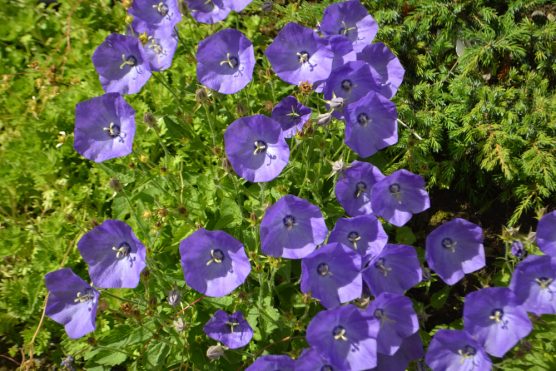
While these flowers take their own sweet time to bloom, it is well worth the wait. These have an elegant and timeless feel to it. They bloom during spring and require partial sunlight. They are perfect for container growing as they don’t require a lot of space or sunlight.
It comes in stunning shades of blue and purple. Bellflowers like these also act as amazing complementary plants as they usually attract loads of bees and butterflies which are agents of pollination.
30. Campanula Lactiflora
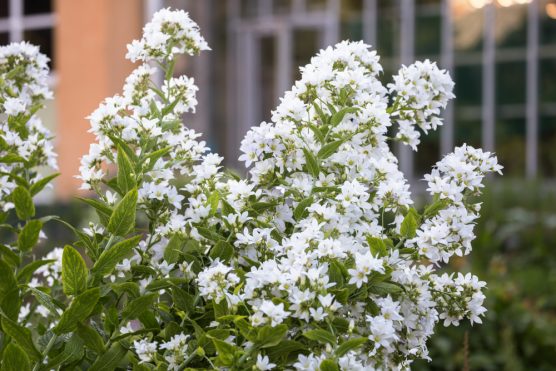
Ending at a wholesome and gorgeous note, these star-shaped flowers are white with a touch of lavender. They are probably the most romantic-looking bellflowers and make for an amazing border plant.
It automatically transports you back into the 1960s. They grow in beautiful big clusters and also keep pests out of the garden. So not only are they eye-catching but also extremely practical. They are not that difficult to take care of and fairly perennial if grown in the right climatic conditions.
Well, there you have it! The most beautiful and practical bellflowers are enumerated above. I made sure to cover all climatic conditions so no matter where you live, you can always have the sweet fragrance of bellflowers wafting in the air.
Bellflowers are quite easy to grow, so you don’t have to be a pro in gardening to enjoy their beauty. And some are container friendly as well! So what are you waiting for? Go get yourself a Bellflower now!

